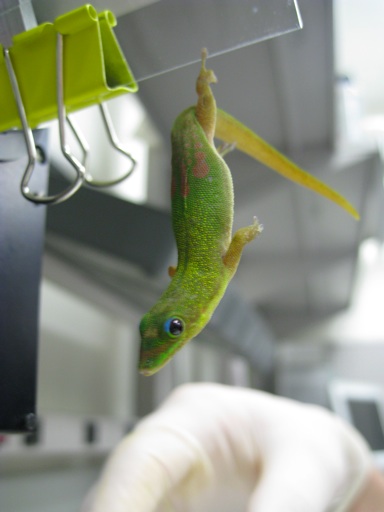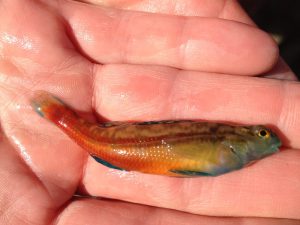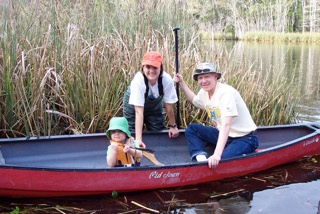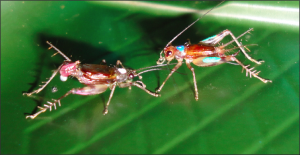
A male anole lizard showing his bright dewlap.
The activities are as follows:
- Teacher Guide
- Student activity, Graph Type A, Level 3
- Student activity, Graph Type B, Level 3
- Student activity, Graph Type C, Level 3
- PowerPoint of images and graphs
- Grading Rubric
Natural selection happens when differences in traits within a population give some individuals a better chance of surviving and reproducing than others. Traits that are beneficial are more likely to be passed on to future generations. However, sometimes a trait may be helpful in one context and harmful in another. For example, some animals communicate with other members of their species through visual displays. These signals can be used to defend territories and attract mates, which helps the animal reproduce. However, these same bright and colorful signals can draw the unwanted attention of predators.
Brown anoles are small lizards that are abundant in Florida and the Caribbean. They have an extendable red and yellow flap of skin on their throat, called a dewlap. To communicate with other brown anoles, they extend their dewlap and move their head and body. Males have particularly large dewlaps, which they often display in territorial defense against other males and during courtship with females. Females have much smaller dewlaps and use them less often.

Aaron with a baby anole lizard.
Aaron is a scientist interested in how natural selection might affect dewlap size in male and female brown anoles. He chose to work with anoles because they are ideal organisms for studies of natural selection; they are abundant, easy to catch, and have short life spans. Aaron wanted to know whether natural selection was acting in different ways for males and females to cause the differences in dewlap size. He thought that a male with a larger dewlap may be more effective at attracting females and passing on his genes to the next generation. However, males with larger, showy dewlaps may catch the eye of more predators and have higher chances of being eaten. Aaron was curious about this tradeoff and how it affected natural selection on dewlap size. For female brown anoles, Aaron thought that this tradeoff would be less important for survival because females have smaller dewlaps and use them less frequently as a signal. In other words, there may not be selection on dewlap size in females.
Using a population of brown anoles on a small island in Florida, Aaron set up a study to determine how dewlap size is related to survival and whether there is a difference between the sexes. He worked with his advisor, Robert, and other members of the lab. They designed a study to track every brown anole on the island and see who survived. In May 2015, they caught the adult lizards on the island and recorded their sex, body length, and dewlap size before releasing them with a unique identification number. Then, the lab returned to the island in October and collected all the adults once again to determine who survived and who didn’t. Aaron predicted that male anoles with larger than average dewlap size would be less likely to survive due to an increased risk of predation. He also predicted that dewlap size would not influence female survival.
Featured scientists: Aaron Reedy and Robert Cox from the University of Virginia. Co-written by undergraduate researcher Cara Giordano.
Flesch–Kincaid Reading Grade Level = 10.3
Additional teacher resource related to this Data Nugget:
- For additional images of Robert and Aaron’s research with anoles in Florida, we have created PowerPoint slides that can be shown in class.
- Aaron conducted this research as a graduate student in Robert Cox’s lab. To learn more about anole research, visit the lab’s website. To learn more about Aaron, visit his website.
- To engage students before the Data Nugget and introduce them to brown anoles, check out this video that shows how brown anoles use dewlap signaling to attract mates and send rival males signals during confrontations:








 About Travis: Ever since Travis was a kid, he was interested in animals and wanted to be a paleontologist. He even had many dinosaur names memorized to back it up! In college he discovered evolutionary biology, which drove him to apply for graduate school and become a scientist. There, he fell in love with comparative biomechanics, which combines evolutionary biology and mechanical engineering. Today Travis studies geckos and their sticky toes that allow them to scale surfaces like glass windows and tree branches.
About Travis: Ever since Travis was a kid, he was interested in animals and wanted to be a paleontologist. He even had many dinosaur names memorized to back it up! In college he discovered evolutionary biology, which drove him to apply for graduate school and become a scientist. There, he fell in love with comparative biomechanics, which combines evolutionary biology and mechanical engineering. Today Travis studies geckos and their sticky toes that allow them to scale surfaces like glass windows and tree branches.






 About Carrie: I have been interested in animal behavior and behavioral ecology since my second year in college at the University of Tennessee. I am primarily interested in how variation in ecology and environment affect communication and signaling in birds. I have also studied various types of memory and am interested in how animals learn and use information depending on how their environment varies over space and time. I am currently working on my PhD in Ecology, Evolution, and Conservation Biology at the University of Nevada Reno and once I finish I hope to become a professor at a university so that I can continue to conduct research and teach students about animal behavior. In my spare time I love hiking with my friends and dogs, and watching comedies!
About Carrie: I have been interested in animal behavior and behavioral ecology since my second year in college at the University of Tennessee. I am primarily interested in how variation in ecology and environment affect communication and signaling in birds. I have also studied various types of memory and am interested in how animals learn and use information depending on how their environment varies over space and time. I am currently working on my PhD in Ecology, Evolution, and Conservation Biology at the University of Nevada Reno and once I finish I hope to become a professor at a university so that I can continue to conduct research and teach students about animal behavior. In my spare time I love hiking with my friends and dogs, and watching comedies!











 About Erin: I am fascinated by morphological diversity, and my research aims to understand the selective pressures that drive (and constrain) the evolution of animal form. Competition for mates is a particularly strong evolutionary force, and my research focuses on how sexual selection has contributed to the elaborate and diverse morphologies found throughout the animal kingdom. Using horned beetles as a model system, I am interested in how male-male competition has driven the evolution of diverse weapon morphologies, and how sexual selection has shaped the evolution of physical performance capabilities. I am first and foremost a behavioral ecologist, but my research integrates many disciplines, including functional morphology, physiology, biomechanics, ecology, and evolution.
About Erin: I am fascinated by morphological diversity, and my research aims to understand the selective pressures that drive (and constrain) the evolution of animal form. Competition for mates is a particularly strong evolutionary force, and my research focuses on how sexual selection has contributed to the elaborate and diverse morphologies found throughout the animal kingdom. Using horned beetles as a model system, I am interested in how male-male competition has driven the evolution of diverse weapon morphologies, and how sexual selection has shaped the evolution of physical performance capabilities. I am first and foremost a behavioral ecologist, but my research integrates many disciplines, including functional morphology, physiology, biomechanics, ecology, and evolution.